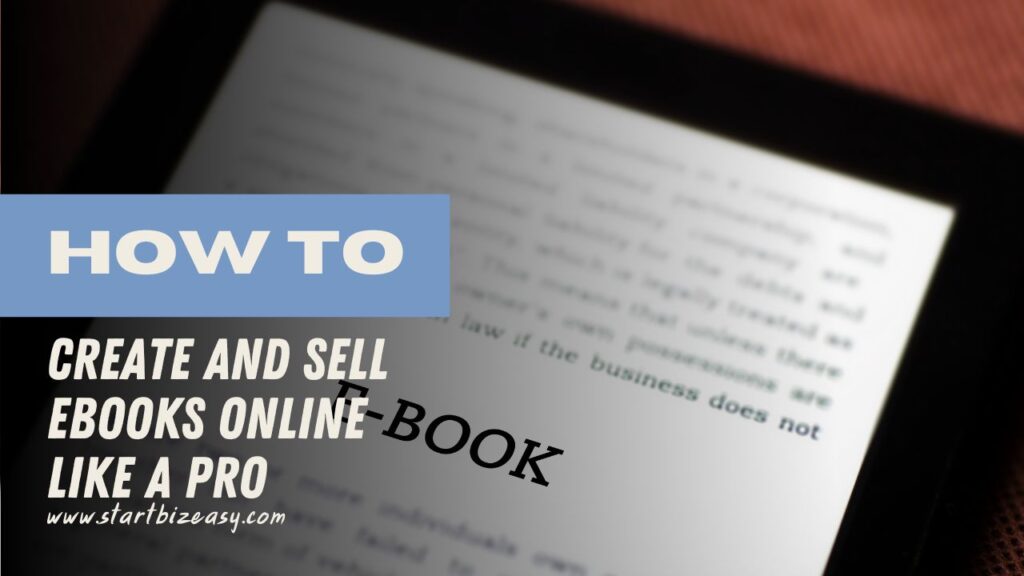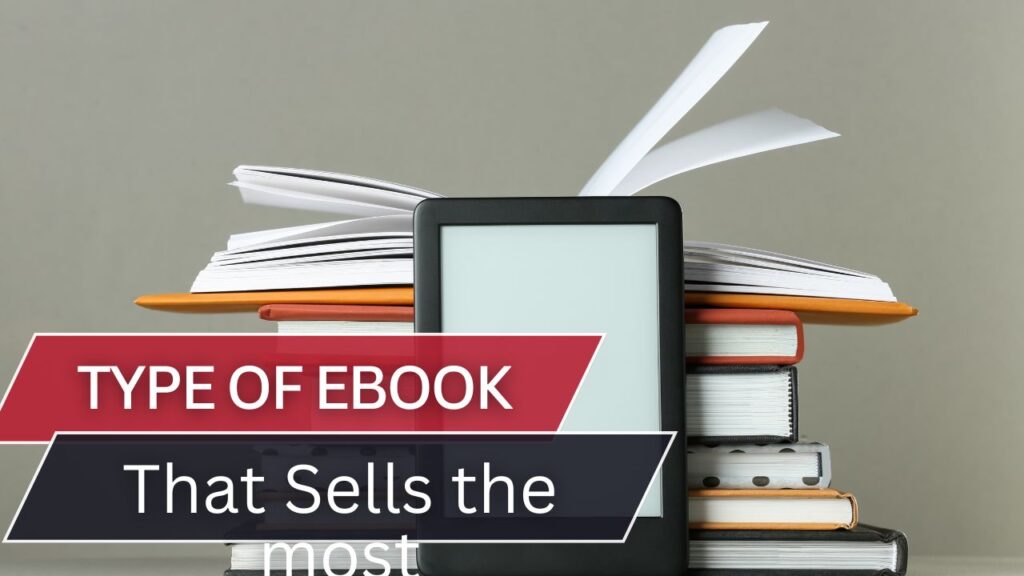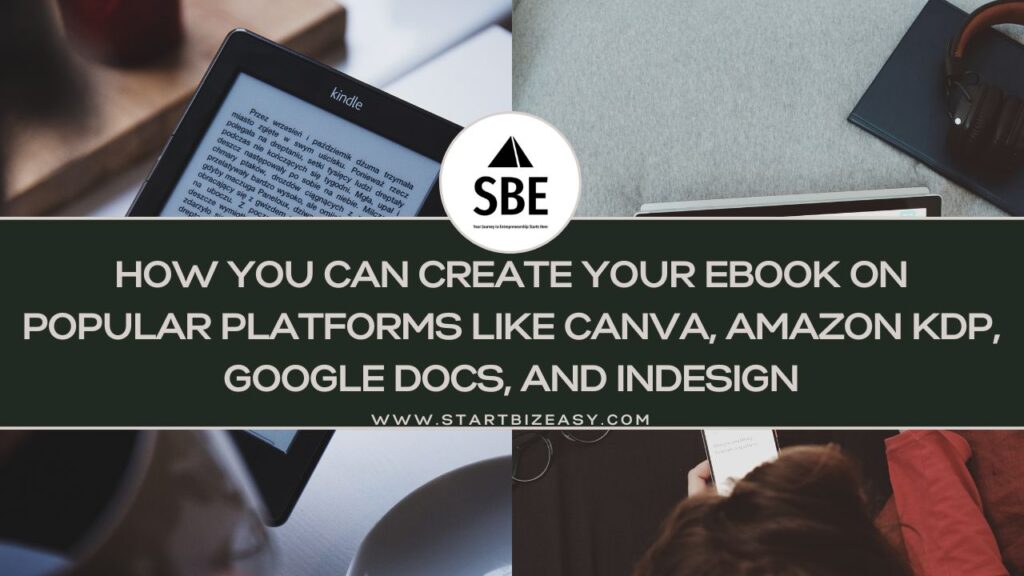
Creating and selling ebooks online has become a lucrative and accessible opportunity for writers, entrepreneurs, and content creators alike. Whether you’re an aspiring author looking to share your stories with the world, a subject matter expert eager to impart knowledge, or a business owner seeking to expand your brand’s reach, the world of ebooks offers a platform for your ideas to thrive.
But how do you go about creating and selling ebooks effectively in the vast digital landscape? This guide is designed to walk you through the process step by step, from conceptualizing your ebook idea to successfully marketing and selling it to your target audience.
Before we reveal how to create and sell eBooks online, what is eBooks and how lucrative is it to start creating and selling eBooks:
“An ebook, short for electronic book, is a digital version of a book that is formatted to be read on electronic devices such as e-readers, tablets, smartphones, or computers.
Ebooks typically replicate the content of a printed book, including text, images, and sometimes multimedia elements, but in a digital format.
They can be purchased, downloaded, and accessed instantly from online stores or libraries, making them convenient for readers who prefer digital reading experiences.
Ebooks offer advantages such as portability, accessibility, and the ability to adjust font sizes and styles, making them popular among readers worldwide”.
Writing and selling eBooks is profitable, allowing authors to earn a significant income. Self-published authors typically earn royalties ranging from 35% to 70% of the eBook’s sale price, depending on the platform and distribution channels used.
Successful eBook authors often supplement their income from eBook sales with other revenue streams, such as speaking engagements, consulting services, online courses, or affiliate marketing. Additionally, authors may leverage their eBooks to build their personal brand, attract clients or customers to their other products or services, or establish themselves as experts in their field.
Now let’s talk about How to Create eBook, after that, we talk about how to sell your eBook.
Table of Contents
How to Create an eBook
1. Research and Choose a Topic:
When embarking on the journey of creating an eBook, the initial step is to meticulously research and select a topic that not only aligns with your interests and expertise but also caters to the needs and interests of your target audience. This involves delving into your own passions and areas of knowledge to identify subjects you are genuinely enthusiastic about exploring further. Simultaneously, it’s essential to understand your audience’s demographics, preferences, and pain points to pinpoint topics that will resonate with them.
Conducting keyword research plays a pivotal role in this process, allowing you to uncover popular search terms and phrases related to your niche. Tools like Google Keyword Planner or SEMrush can provide invaluable insights into the demand for specific topics, helping you gauge their relevance and potential audience reach. Additionally, assessing market demand and competition is crucial in ensuring that there’s a viable audience for your eBook. Analyze factors such as the number of existing resources on the topic, engagement levels, and overall interest within your target market.
Furthermore, consider your unique perspective or angle on the chosen topic. How can you offer a fresh take or provide value that sets your eBook apart from existing offerings? Whether it’s leveraging your personal experiences, expertise, or innovative ideas, strive to bring something distinctive to the table that resonates with your audience.
Here’s a list of eBook topic areas that often have high demand:
- Self-Improvement and Personal Development: Topics like goal setting, productivity hacks, time management, self-discipline, and mindfulness are perennially popular.
- Health and Wellness: With a growing interest in health and wellness, topics such as fitness routines, nutrition plans, stress management techniques, and mental health awareness are in demand.
- Finance and Investing: eBooks on personal finance, budgeting, saving strategies, investing basics, and wealth-building techniques attract readers looking to improve their financial literacy and secure their financial future.
- Entrepreneurship and Business: Entrepreneurship, startups, small business management, marketing strategies, leadership skills, and career development are topics of interest to aspiring and established business owners alike.
- Technology and Digital Skills: With rapid technological advancements, eBooks covering topics like coding, digital marketing, website development, cybersecurity, and data analytics are in high demand.
- Hobbies and Crafts: Hobby-related eBooks, such as photography tips, gardening guides, cooking recipes, DIY projects, and craft tutorials, cater to enthusiasts looking to pursue their passions.
- Fiction and Literature: Fictional genres like mystery, romance, science fiction, fantasy, and thriller novels continue to have a loyal readership. Short story collections and anthologies are also popular.
- Parenting and Family: eBooks offering parenting advice, child-rearing tips, family relationships, and educational resources are sought after by parents seeking guidance and support.
- Travel and Adventure: Travel guides, destination reviews, budget travel tips, adventure stories, and cultural experiences appeal to wanderlust-driven readers looking to explore the world.
- Cooking and Food: Recipe collections, cooking techniques, dietary guidelines, meal planning, and nutrition information attract readers interested in culinary arts and healthy eating.
These are just a few broad topic areas with high demand, but there are countless niche subjects within each category that can also find success in the eBook market. It’s essential to conduct thorough research and identify specific topics that resonate with your target audience and align with your expertise and interests.
2. Outline Your Content:
After selecting a topic for your eBook, the next step is to outline its content systematically. This involves creating a structure that organizes the key points and concepts you want to cover, providing a clear roadmap for the writing process.
To begin, break down your content into manageable sections or chapters. Consider the overarching themes or concepts within your chosen topic and divide them into logical segments. Each section should focus on a specific aspect or subtopic, allowing for a cohesive flow of information throughout the eBook.
Within each section, outline the main ideas or key points you intend to discuss. These could be insights, arguments, case studies, practical tips, or examples relevant to your topic. By outlining the main ideas, you ensure that you cover all essential information comprehensively and effectively.
Think of your outline as a skeleton for your eBook, providing structure and guidance for the writing process. It helps you organize your thoughts, prioritize content, and maintain coherence and clarity throughout the text. Additionally, an outline serves as a reference point to ensure that you stay on track and cover all planned content areas.
Ultimately, creating a detailed outline for your eBook acts as a roadmap, guiding you through the writing process and ensuring that your content is well-structured, comprehensive, and engaging for your readers.
3. Write Your Content:
Once you’ve crafted a detailed outline for your eBook, it’s time to bring your content to life through writing. Armed with your outline as a guide, begin drafting your eBook’s content with clarity, engagement, and value at the forefront of your mind.
When writing, strive for clarity by expressing your ideas in a straightforward and understandable manner. Avoid jargon or overly complex language that might confuse your readers. Instead, aim for simplicity without sacrificing depth or substance.
Engagement is key to keeping your readers invested in your eBook. Use storytelling techniques, examples, anecdotes, and real-life scenarios to illustrate your points and make your content relatable. Incorporating visuals such as images, charts, or graphs can also enhance engagement and aid comprehension.
Remember to prioritize providing value to your readers throughout your writing process. Address their needs, concerns, and interests by offering practical insights, actionable advice, or solutions to their problems. Consider what your audience stands to gain from reading your eBook and tailor your content accordingly.
Keep your target audience in mind as you write, adapting your tone, style, and level of complexity to suit their knowledge and expertise. Whether you’re writing for beginners or experts in your field, ensure that your content is accessible and relevant to your readers’ needs and interests.
4. Editing and Proofreading:
Once you’ve completed the first draft of your eBook, the editing and proofreading stage is essential to refine your content to its highest quality. Begin by thoroughly reviewing your work for clarity, coherence, and accuracy. Ensure that your ideas flow logically and are presented in a cohesive manner. Check for any inaccuracies or inconsistencies in the information you’ve provided.
As you read through your eBook, pay close attention to grammatical errors, typos, and punctuation mistakes. Use spelling and grammar checkers like Grammarly, and ProWritingAid, but also take the time to manually review your text, as automated tools may not catch all errors. Correct any misspellings, incorrect verb tenses, or punctuation errors that you come across.
Maintain consistency in your eBook’s style and tone throughout. Ensure that your writing style remains uniform, and that the tone of your content aligns with your intended message and audience. Be mindful of any abrupt shifts in tone or style that may disrupt the flow of your eBook.
Consider seeking feedback from beta readers—trusted individuals who can provide honest feedback on your content. Beta readers can offer valuable insights into areas for improvement, identify unclear or confusing sections, and provide suggestions for enhancing readability.
If feasible, invest in hiring a professional editor to polish your eBook to perfection. A skilled editor can provide comprehensive feedback, correct grammatical errors, improve sentence structure, and ensure consistency in style and tone. While this may involve additional costs, the investment can significantly elevate the quality of your eBook and enhance your credibility as an author.
By meticulously editing and proofreading your eBook, you ensure that it meets the highest standards of quality and professionalism. A polished and error-free eBook not only enhances your reputation as an author but also improves the reading experience for your audience. Dedicate the time and effort to refine your content, and your eBook will stand out in the digital marketplace.
5. Design/Layout and Create a Cover:
When it comes to designing the layout of your eBook and crafting its cover, visual appeal and functionality are key considerations. The layout should be aesthetically pleasing while ensuring readability across various devices. Select a font that is clean, clear, and easy to read, especially on digital screens. Incorporate formatting elements like headings, subheadings, and bullet points to organize your content effectively and improve navigation.
When designing your eBook cover, aim for a professional and eye-catching design that reflects the content and tone of your book. Choose visuals and typography that resonate with your target audience and convey the essence of your eBook. Consider the genre, theme, and mood of your content to guide your design choices. Use high-quality images or graphics that enhance visual appeal and capture readers’ attention. Keep the cover design simple and uncluttered, avoiding excessive text or imagery that may detract from its impact. A well-designed cover can make a significant difference in attracting readers and enticing them to explore your eBook further.
6. Format Your eBook:
Formatting your eBook for digital distribution is essential to ensure a smooth reading experience for your audience across different devices and platforms. Once your content and design are finalized, you need to convert your manuscript into popular eBook formats such as PDF, ePub, or mobi. These formats are widely compatible with various e-readers, tablets, and smartphones, allowing your eBook to reach a broader audience.
When formatting your eBook, attention to detail is crucial. You must pay close attention to elements such as page breaks, hyperlinks, and image placement to maintain readability and functionality. Strategic use of page breaks helps control the flow of your content and ensures that chapters or sections begin on new pages, preventing awkward formatting issues, especially on smaller screens.
Hyperlinks within your eBook should be functional and lead to the intended destinations. It’s essential to test all hyperlinks to ensure they work correctly and provide a seamless browsing experience for readers. Additionally, images should be optimized for digital display and positioned correctly within the text to enhance rather than disrupt the reading experience.
Consistency in formatting is key to creating a cohesive reading experience. Maintain consistent font styles, sizes, and formatting elements throughout your eBook to avoid confusion and enhance readability.
In addition to eBooks, consider creating audiobook versions of your content to cater to auditory learners and readers who prefer listening to books. You can produce audiobooks yourself if you have the necessary equipment and skills, or you can hire professional narrators and audio producers. Distribute your audiobook through platforms like Audible, ACX, or Findaway Voices to reach audiobook listeners worldwide.
By paying attention to these formatting considerations, you can ensure that your eBook displays and plays correctly on various devices and platforms, providing an enjoyable and seamless reading and listening experience for your audience.
7. Publish Your eBook:
Once your eBook is ready for publication, the next step is to choose a platform or marketplace where you can publish and distribute it to reach your audience. There are several options available, including self-publishing platforms like Amazon Kindle Direct Publishing (KDP), Smashwords, Apple Books, Kobo, or even your own website.
When selecting a platform, consider factors such as audience reach, ease of use, and royalty rates. Amazon KDP, for example, offers access to a vast audience of Kindle users and provides tools to help authors manage their eBooks effectively. Smashwords offers distribution to multiple online retailers, expanding your eBook’s reach beyond just one platform. Alternatively, publishing your eBook on your own website gives you full control over pricing, distribution, and branding.
Once you’ve chosen a platform, follow its guidelines for uploading and publishing your eBook. This typically involves creating an account, formatting your eBook according to the platform’s specifications, and providing relevant metadata such as title, description, and keywords. Set the price for your eBook and choose distribution options such as geographical restrictions or enrollment in lending programs.
Before publishing, it’s essential to review your eBook thoroughly to ensure that it meets quality standards and complies with any formatting requirements. Once published, monitor your eBook’s performance and adjust your marketing and promotion efforts accordingly to maximize its visibility and sales potential.
Here are both free and paid website platforms or marketplaces where you can publish and sell your ebook:
Free Platforms:
- Amazon Kindle Direct Publishing (KDP): KDP allows you to self-publish your ebook for free on Amazon’s Kindle Store. You can set your own pricing, retain control over your rights, and reach millions of readers worldwide.
- Smashwords: Smashwords is a free ebook publishing platform that distributes ebooks to major retailers such as Apple Books, Barnes & Noble, and Kobo, as well as smaller retailers and libraries.
- Draft2Digital: Draft2Digital is another free ebook distribution platform that helps authors publish and distribute ebooks to various retailers, including Amazon, Apple Books, Barnes & Noble, and more.
- Google Play Books Partner Center: Google Play Books Partner Center allows you to self-publish and sell ebooks on the Google Play Store for free. You can set your own pricing and reach Android users worldwide.
Paid Platforms:
- BookBaby: BookBaby offers ebook publishing services for a fee, including ebook conversion, distribution to major retailers, and marketing tools to help authors reach their target audience.
- Lulu: Lulu provides ebook publishing services for a fee, allowing authors to create, publish, and distribute ebooks in various formats. They also offer print-on-demand services for authors interested in print versions of their books.
- PublishDrive: PublishDrive is a paid ebook distribution platform that offers a wide range of distribution options, including major retailers, subscription services, and international markets, for a fee.
- Booktango: Booktango is a self-publishing platform that offers ebook publishing services for a fee. They provide ebook conversion, distribution, and marketing tools to help authors publish and sell their ebooks.
These platforms offer different features, pricing structures, and distribution options, so it’s essential to research and choose the one that best fits your needs and budget. Additionally, consider factors such as royalties, publishing rights, and marketing support when selecting a platform to publish and sell your ebook.
How to Sell an eBook Online
1. Choose Your Sales Platform:
Selecting the right sales platform is a crucial decision when selling your eBook. Here’s how to approach it:
Firstly, consider the audience reach of each platform. Platforms like Amazon Kindle Direct Publishing (KDP) have a vast user base, offering exposure to millions of potential buyers. Smashwords provides distribution to multiple online retailers, expanding your reach beyond a single platform. Barnes & Noble Press targets readers who prefer purchasing eBooks from traditional bookstores. Alternatively, selling through your own website gives you control over your audience and branding.
Secondly, evaluate the royalty rates offered by each platform. Different platforms offer varying royalty rates, which affect your earnings per sale. Consider the balance between higher royalties and the potential for increased sales volume on platforms with broader audience reach.
Lastly, assess the level of control you have over pricing and distribution. Some platforms may impose restrictions on pricing or exclusive distribution agreements, limiting your flexibility as an author. Evaluate whether you prefer the convenience of a ready-made marketplace or the autonomy of selling directly through your own website.
Ultimately, weigh these factors against your specific goals and priorities to determine the best sales platform for your eBook. By choosing a platform that aligns with your needs and preferences, you can maximize your eBook’s visibility, earnings, and overall success.
2. Set Your Price:
When determining the price for your eBook, it’s essential to take a comprehensive approach. Start by researching pricing strategies within your niche. Look at similar eBooks to understand the typical price range and analyze what competitors are charging. Consider the length and content of your eBook; longer or more comprehensive works may justify a higher price point, while shorter ones may need to be priced lower.
Evaluate the uniqueness of your eBook within the market. If it offers something truly distinctive or fills a gap, you may be able to charge more. Conversely, if it covers well-trodden ground or competes with many similar titles, you may need to adjust your pricing strategy accordingly.
Factor in the perceived value of your eBook to potential buyers. Think about the benefits it offers and how it addresses their needs or interests. Price your eBook in a way that reflects its value, considering factors such as expertise, authority, and credibility.
Finally, experiment with different price points to find the optimal balance between sales volume and revenue. Monitor sales closely and be prepared to adjust your pricing strategy based on market feedback and performance metrics. By taking a thoughtful and strategic approach to pricing, you can maximize both sales and revenue for your eBook.
3. Optimize Your eBook Listing:
When optimizing your eBook listing, you want to make it irresistible to potential buyers while also making it easy for them to find. Start by crafting a compelling product description that clearly communicates the benefits and value of your eBook. Highlight what readers will gain from it and why it’s worth their investment. Use persuasive language to draw them in and encourage them to make a purchase.
Next, incorporate relevant keywords throughout your product description to improve its visibility in search results. Think about the terms and phrases your target audience is likely to use when searching for eBooks in your niche. By including these keywords naturally in your description, you increase the chances of your eBook being discovered by potential buyers.
Lastly, ensure that your eBook cover is visually appealing and accurately represents the content of your eBook. Invest in a professional cover design that captures attention and conveys the tone and subject matter of your eBook effectively. A well-designed cover can make a significant difference in attracting potential buyers and enticing them to explore your eBook further.
4. Market Your eBook:
To effectively market your eBook, you need a strategic plan that engages your target audience and drives sales. Start by identifying your audience demographics and preferences, allowing you to tailor your marketing efforts accordingly.
Utilize a variety of tactics to maximize your reach and engagement. Social media marketing is essential; leverage platforms like Facebook, X, Tiktok, and Instagram to share promotional content and engage with your audience. Email marketing is another powerful tool; build an email list and send regular newsletters and updates to keep subscribers informed and engaged.
Content marketing is key to establishing credibility and attracting potential buyers. Create valuable content related to your eBook’s topic, such as blog posts, articles, or videos, to provide insights and value to your audience.
Consider collaborating with influencers or industry experts to reach a wider audience and leverage their credibility. Paid advertising channels like Google Ads or Facebook Ads can also help target specific audiences and drive traffic to your eBook listing.
Engage actively with your audience across various platforms to build anticipation and credibility for your eBook. Respond to comments, participate in discussions, and seek feedback to foster a sense of community.
Create buzz and excitement around your eBook launch by sharing sneak peeks, behind-the-scenes insights, and excerpts. Use analytics tools to track the performance of your marketing efforts and adjust your strategy accordingly based on data-driven insights.
By developing a comprehensive marketing plan that utilizes a variety of tactics to engage your audience and generate excitement, you can effectively promote your eBook and drive sales.
5. Offer Promotions and Discounts:
Alongside your marketing tactics, you should leverage promotional and discount strategies to encourage impulse purchases from your target audience.
Consider running limited-time promotions or discounts to incentivize purchases and create a sense of urgency among potential buyers. For example, you could offer a discounted price for a short period, such as a weekend sale or a holiday promotion.
Use strategies like countdown deals to create excitement and encourage impulse purchases. A countdown timer can create a sense of urgency and encourage customers to take advantage of the discount before it expires.
Another tactic is to offer free sample chapters or excerpts of your eBook to give potential buyers a taste of what they can expect. This allows them to preview your content and make an informed decision about purchasing the full eBook.
Bundle discounts are another effective way to incentivize purchases. You can bundle your eBook with related products or additional content, such as companion guides or bonus materials, and offer them at a discounted price compared to purchasing them separately.
By offering promotions and discounts, you not only encourage sales but also attract new customers who may be enticed by the discounted price or the opportunity to sample your eBook before committing to a purchase. Use these strategies strategically to create urgency, encourage sales, and expand your customer base.
6. Collect Reviews and Testimonials:
The collection of reviews and testimonials involves actively encouraging readers to share their feedback and experiences with your ebook. This can be done by providing gentle reminders within your ebook itself, at the end of the book or in the acknowledgments section, asking readers to consider leaving a review if they found the book valuable.
Another approach is to offer review copies of your ebook to influencers, bloggers, and book reviewers in your ebook’s niche or genre. Identify individuals or organizations with an audience interested in similar content, and reach out to them with a complimentary copy of your ebook in exchange for an honest review or testimonial. Personalize your outreach and explain why you believe your ebook would be of interest to their audience, highlighting its unique value propositions and benefits. Follow up politely and courteously to inquire about their thoughts on your ebook and to thank them for their time and consideration.
Both of these strategies aim to increase the visibility and credibility of your ebook by leveraging the opinions and experiences of others.
Note that, positive reviews serve as endorsements of your eBook’s quality and value, helping to convince potential buyers that it’s worth their investment.
In addition to influencing potential buyers, reviews also play a role in improving your eBook’s visibility in search results. Many online platforms use reviews and ratings as ranking factors, so the more positive reviews your eBook receives, the higher it may appear in search results.
7. Monitor and Optimize:
Regularly track your eBook sales and performance metrics to gain insights into its effectiveness. Monitor metrics such as sales volume, conversion rates, and customer feedback to understand how well your eBook is performing in the market.
By analyzing sales volume, you can assess the overall success of your eBook and identify trends or patterns in purchasing behavior. Pay attention to fluctuations in sales over time and investigate any significant changes to understand their underlying causes.
Conversion rates are another important metric to track. Analyze the percentage of visitors to your eBook listing who ultimately make a purchase. Identify areas where conversion rates may be low and explore ways to improve them, such as optimizing your product description or adjusting your pricing strategy.
Customer feedback is invaluable for understanding your audience’s preferences and needs. Pay attention to reviews, ratings, and comments from readers to gather insights into what they liked or disliked about your eBook. Use this feedback to refine your content, marketing strategies, and overall approach.
Based on your analysis, refine your marketing strategies and optimize your sales process accordingly. Experiment with different tactics, such as adjusting pricing, targeting new audience segments, or launching promotional campaigns, to see what works best for driving sales and engagement.
Continuously monitor and evaluate your eBook’s performance over time, making adjustments as needed to ensure its ongoing success.
How much does it cost to make an eBook?
Taking all factors into account, the total cost of making/creating an eBook ranges from approximately $1,000 to $5,000 or more. However, it’s important to note that the actual costs may vary significantly based on individual circumstances and choices.
This cost will be spread among several factors such as:
- Writing and Content Creation: If you’re writing the eBook yourself, the cost is primarily your time and effort. If you’re hiring a ghostwriter or freelancer, costs can range from a few hundred to several thousand dollars, depending on the scope of the project.
- Editing and Proofreading: Professional editing and proofreading services can cost between $500 to $2,000 or more, depending on the extent of the editing required and the rates of the editor.
- Cover Design: A professional eBook cover design typically costs between $100 to $500 or more, depending on the designer’s experience and the complexity of the design.
- Formatting and Layout: Formatting services can range from $50 to $200 or more, depending on the complexity of your eBook and the provider’s rates.
- Illustrations and Graphics: Costs for illustrations or graphics can vary widely depending on the number and complexity of the visuals needed.
- Conversion to eBook Format: Professional eBook conversion services may cost around $50 to $200 or more, depending on the complexity of your eBook and the provider’s rates.
- Marketing and Promotion: Costs for marketing and promotion can vary greatly depending on your budget and strategy, ranging from a few hundred to several thousand dollars or more.
Keep in mind that the length and complexity of your eBook, the quality of services you opt for, and whether you’re managing tasks independently or hiring professionals will significantly impact the cost of creating your eBook.
Type of eBook that Sells the most

Several genres and topics tend to consistently perform well in terms of sales:
- Romance: Romance novels are perennial bestsellers, appealing to a wide audience of readers who enjoy stories of love, relationships, and emotional connections. Subgenres like contemporary romance, historical romance, and paranormal romance are particularly popular.
- Mystery and Thriller: Readers love suspenseful and gripping stories that keep them on the edge of their seats. Mystery and thriller novels, including crime fiction, detective stories, and psychological thrillers, often top bestseller lists.
- Self-Help and Personal Development: eBooks that offer practical advice, guidance, and strategies for personal growth, self-improvement, and achieving success are in high demand. Topics such as productivity, mindset, goal-setting, and motivation are particularly popular.
- Fantasy and Science Fiction: Readers of all ages enjoy escaping into fantastical worlds filled with magic, adventure, and futuristic technologies. Fantasy and science fiction novels, including epic fantasies, dystopian tales, and space operas, have a dedicated fan base.
- Cookbooks and Recipe Collections: With the rise of food blogs and cooking shows, eBooks that offer mouthwatering recipes, cooking tips, and culinary inspiration are in demand. Cookbooks covering specific cuisines, dietary preferences, or cooking techniques are especially popular.
- Young Adult Fiction: Young adult (YA) fiction appeals to readers of all ages with its relatable characters, coming-of-age themes, and compelling storylines. YA novels encompass a wide range of genres, including contemporary, fantasy, romance, and dystopian fiction.
- Historical Fiction: Historical fiction transports readers to different time periods and places, offering a blend of entertainment and education. Novels set in well-researched historical settings, featuring richly drawn characters and vivid storytelling, often resonate with readers.
- Non-Fiction How-To Guides: eBooks that provide practical guidance, step-by-step instructions, and actionable tips on topics such as fitness, health, finance, hobbies, and skills development are sought after by readers looking to learn and improve their lives.
While these genres tend to sell well, it’s important to remember that current trends can affect ebook demand, reader preferences can change over time, and there’s no one-size-fits-all formula for success. Ultimately, the key to selling the most eBooks is to write engaging, well-crafted content that resonates with your target audience and delivers value to readers.
What Software do you need to Write an eBook?
To write an eBook, you primarily need a word processing software that allows you to create and format your content. Here are some commonly used software options:
- Microsoft Word: Microsoft Word is one of the most popular word processing software used for writing eBooks. It offers a range of formatting tools, templates, and features that make it easy to create professional-looking documents.
- Google Docs: Google Docs is a free, cloud-based word processing tool that allows you to collaborate with others in real-time. It offers similar features to Microsoft Word and is accessible from any device with an internet connection.
- Scrivener: Scrivener is a specialized writing software designed specifically for authors and novelists. It offers advanced organizational tools, outlining features, and project management capabilities that are ideal for longer writing projects like eBooks.
- Apple Pages: Pages is a word processing software developed by Apple, designed for use on macOS and iOS devices. It offers intuitive formatting tools and templates for creating visually appealing documents.
- LibreOffice Writer: LibreOffice Writer is a free, open-source word processing software that offers many of the same features as Microsoft Word. It is compatible with multiple operating systems, including Windows, macOS, and Linux.
- Adobe InDesign: InDesign is a professional layout and design software commonly used for creating eBooks with complex layouts, graphics, and multimedia elements. It is ideal for authors who require precise control over the design and formatting of their eBooks.
- Google Keep or Evernote: These note-taking apps are useful for jotting down ideas, organizing research notes, and capturing inspiration on the go. They sync across devices, making it easy to access your notes from anywhere.
- Markdown Editors: Markdown editors like Typora or Visual Studio Code with Markdown extensions are popular among writers who prefer a lightweight, distraction-free writing environment. Markdown syntax allows you to format text with simple, intuitive symbols.
- LaTeX: LaTeX is a typesetting system commonly used for writing technical and scientific documents, including eBooks. It offers precise control over formatting and produces high-quality output suitable for complex layouts and mathematical equations.
- Grammarly or ProWritingAid: These writing assistance tools can help you improve the clarity, coherence, and correctness of your writing by offering suggestions for grammar, spelling, punctuation, and style improvements.
- Book Writing Software: Dedicated book writing software like Ulysses, yWriter, or Storyist offers features tailored to the needs of authors, including character and plot organization, storyboarding, and manuscript tracking.
- Adobe InDesign: For more complex layouts and design-heavy eBooks, Adobe InDesign is a professional layout and design software commonly used by graphic designers and publishers. It offers advanced typography, layout, and image editing features.
These are just a few examples of the software options available for writing eBooks. Ultimately, the best software for you will depend on your specific needs, preferences, and budget. Whether you choose a basic word processor or a more specialized writing tool, the most important thing is to find software that helps you effectively organize your ideas and create compelling content for your eBook.
Are eBooks Hard to Sell?
Selling eBooks can be challenging, but it’s not necessarily harder than selling other products or services. The success of an eBook depends on various factors such as the quality of the content, the relevance to the target audience, the effectiveness of marketing efforts, and the competitiveness of the market.
One of the advantages of eBooks is that they can reach a global audience quickly and cost-effectively, especially when sold through online platforms. However, the ease of distribution also means that there is a lot of competition in the eBook market, making it essential for authors to differentiate their eBooks and effectively promote them to stand out.
Successful eBook sales often require authors to invest time and effort in creating high-quality content, building a loyal readership, and implementing effective marketing strategies. By understanding their target audience, addressing their needs and interests, and engaging with them through various channels, authors can increase their chances of selling their eBooks successfully.
While selling eBooks may present challenges, many authors have achieved significant success by leveraging digital publishing platforms and implementing innovative marketing tactics to reach and engage their audience. With dedication, perseverance, and strategic planning, selling eBooks can be a rewarding endeavor for authors.
How to Create an eBook for Free
Creating an eBook for free is entirely feasible with the wealth of available resources and tools. Here’s a streamlined guide to help you through the process:
Firstly, choose a topic that you’re passionate about and knowledgeable in. This ensures that you can provide valuable insights and engage your audience effectively.
Next, outline the structure of your eBook, breaking down your content into chapters or sections. This step serves as a roadmap for your writing process, ensuring that you cover all essential points.
With your outline in hand, start writing your eBook content using a word processing software like Google Docs or Microsoft Word. Focus on clarity, coherence, and providing value to your readers.
Once your content is written, design the layout of your eBook using free design tools like Canva or Adobe Spark. Choose a clean and readable font, incorporate images or graphics to enhance your content, and ensure that your eBook is visually appealing.
After designing your eBook, format it for digital distribution using free online converters or eBook creation tools. Convert your manuscript into popular eBook formats like PDF, ePub, or mobi to ensure compatibility with various devices and platforms.
Proofread and edit your eBook thoroughly to ensure that it’s free of grammar, spelling, and formatting errors. Consider using free online editing tools like Grammarly or Hemingway Editor to assist you in this process.
Create a cover for your eBook that accurately represents the content and catches the reader’s attention. Utilize free online design tools or royalty-free images to design a professional-looking cover.
Finally, publish your eBook on free self-publishing platforms like Amazon Kindle Direct Publishing (KDP), Smashwords, or Draft2Digital. Follow the platform’s guidelines for uploading your eBook and setting the price and distribution options.
By following these steps, you can create and publish an eBook for free, allowing you to share your knowledge and expertise with the world without breaking the bank.
How you can Create Your eBook on Popular Platforms like Canva, Amazon KDP, Google Docs, and InDesign

How to Create an eBook in Canva
Creating an eBook in Canva is a straightforward process that allows you to design professional-looking layouts with ease. Here’s how you can create an eBook in Canva:
- Sign Up or Log In: Visit the Canva website (www.canva.com) and sign up for a free account if you don’t already have one. If you have an account, log in to access the Canva dashboard.
- Choose a Template: Once logged in, click on the “Create a design” button and type “eBook” into the search bar. Canva offers a variety of eBook templates to choose from. Browse through the available options and select a template that best fits your eBook’s style and content.
- Customize Your Design: After selecting a template, you’ll be taken to the Canva editor where you can customize your eBook design. You can change the background, add text, insert images or graphics, and adjust the layout to suit your preferences. Canva provides a user-friendly drag-and-drop interface, making it easy to customize your eBook design.
- Add Your Content: Replace the placeholder text and images in the template with your own content. You can type directly into the text boxes to add your eBook’s title, subtitle, chapter headings, and body text. Upload your own images or choose from Canva’s extensive library of stock photos and illustrations to enhance your eBook’s visual appeal.
- Format Your eBook: Once you’ve added your content, you can format your eBook to make it visually appealing and easy to read. Adjust the font style, size, and color to ensure readability. Use formatting elements like headings, subheadings, and bullet points to organize your content effectively.
- Review and Edit: Review your eBook design to ensure that everything looks polished and professional. Make any necessary adjustments or edits to improve the overall appearance and readability of your eBook.
- Download or Share Your eBook: Once you’re satisfied with your eBook design, you can download it in PDF format by clicking the “Download” button in the top-right corner of the Canva editor. You can also share your eBook directly from Canva by clicking the “Share” button and selecting your preferred sharing option.
By following these steps, you can create an eBook in Canva quickly and easily, allowing you to showcase your content in a visually appealing and professional manner.
How to Create an eBook to Sell on Amazon KDP
To create an eBook to sell on Amazon, you’ll need to follow these steps:
- Prepare Your Manuscript: Write your eBook using a word processing software like Microsoft Word or Google Docs. Ensure that your manuscript is properly formatted with clear headings, paragraphs, and chapter breaks.
- Convert Your Manuscript: Once your manuscript is ready, convert it into a compatible eBook format. Amazon Kindle Direct Publishing (KDP) accepts eBooks in formats such as .doc, .docx, .html, .mobi, .epub, and .rtf. You can use software like Calibre or online converters to convert your manuscript into the appropriate format.
- Create a KDP Account: If you don’t already have one, sign up for an account on Amazon Kindle Direct Publishing (KDP) at kdp.amazon.com. You’ll need to provide some basic information and agree to the terms and conditions.
- Enter eBook Details: Once logged in to your KDP account, click on “Add a New Title” and enter the details of your eBook, including the title, author name, description, keywords, and categories. Upload your eBook file and cover image.
- Set Pricing and Royalties: Choose the pricing and royalty options for your eBook. You can set the price in different regions and select between 35% and 70% royalty rates, depending on the pricing options you choose and the territories where you plan to sell your eBook.
- Preview Your eBook: Use the KDP Previewer tool to review how your eBook will appear to readers on different devices. Make sure that your eBook looks good and is properly formatted before publishing.
- Publish Your eBook: Once you’re satisfied with the preview, click the “Publish Your Kindle eBook” button to make your eBook available for sale on Amazon. Your eBook will typically be available for purchase within 24 to 48 hours.
- Promote Your eBook: After publishing your eBook, promote it to reach a wider audience. You can use various marketing tactics such as social media promotion, email marketing, book giveaways, and advertising to drive sales and increase visibility.
By following these steps, you can create and publish an eBook for Amazon Kindle Direct Publishing, making your content available to millions of readers worldwide.
How to Create an eBook in Google Docs
Creating an eBook in Google Docs is a straightforward process. Here’s a step-by-step guide to help you get started:
- Open Google Docs: Visit the Google Docs website (docs.google.com) and sign in to your Google account. If you don’t have an account, you can create one for free.
- Start a New Document: Click on the “Blank” option to start a new document. This will open a blank Google Docs document where you can begin writing your eBook.
- Format Your Document: Set up your document formatting by adjusting the font style, size, and spacing to your preferences. You can also create headings, subheadings, and other formatting elements to organize your content.
- Write Your Content: Begin writing your eBook content directly into the Google Docs document. Write each chapter or section of your eBook as separate sections within the document.
- Add Images and Graphics: To enhance your eBook’s visual appeal, you can insert images, graphics, charts, or other visual elements into your Google Docs document. Click on “Insert” in the top menu and select “Image” to upload images from your computer or select from Google’s image library.
- Create a Table of Contents: If your eBook contains multiple chapters or sections, you can create a table of contents to help readers navigate through the document. To do this, use the “Insert” menu to add headings for each chapter or section, then select “Table of contents” from the “Insert” menu to generate a clickable table of contents.
- Review and Edit: Once you’ve finished writing your eBook content, review and edit your document for grammar, spelling, and formatting errors. Make any necessary revisions to ensure that your eBook is polished and professional.
- Export Your eBook: When you’re satisfied with your eBook, export it from Google Docs in a compatible eBook format such as PDF or ePub. To do this, click on “File” in the top menu, then select “Download” and choose your desired file format.
- Publish or Distribute Your eBook: After exporting your eBook from Google Docs, you can publish it on platforms like Amazon Kindle Direct Publishing (KDP) or distribute it through other channels to make it available to readers.
By following these steps, you can create an eBook in Google Docs quickly and easily, allowing you to share your content with readers around the world.
How to Create an eBook in InDesign
Creating an eBook in Adobe InDesign allows for precise layout design and professional formatting. Here’s a guide on how to do it:
- Set Up Your Document: Open Adobe InDesign and create a new document by selecting “File” > “New” > “Document.” Choose the appropriate page size and orientation for your eBook. Consider using standard eBook dimensions like 6×9 inches.
- Design Your Layout: Use the various tools and panels in InDesign to design your eBook layout. Arrange text frames, images, and other elements on the pages to create your desired design. Ensure that your layout is visually appealing and well-organized for readability.
- Import Your Content: Copy and paste your written content into text frames within your InDesign document. Format the text using styles to maintain consistency throughout your eBook. You can also import images, graphics, and other media files to enhance your content.
- Create Hyperlinks and Cross-References: If your eBook contains hyperlinks or cross-references, use the Hyperlinks panel and Cross-References panel in InDesign to create them. Hyperlink text to external websites, email addresses, or other pages within your eBook for easy navigation.
- Add Interactive Elements (Optional): InDesign allows you to add interactive elements to your eBook, such as buttons, audio, video, and slideshows. Use the Buttons and Forms panel to create interactive buttons or the Media panel to embed multimedia files.
- Export Your eBook: Once your eBook design is complete, it’s time to export it in a format suitable for digital distribution. To export your eBook, go to “File” > “Export” > “Format” and choose “Adobe PDF (Interactive)” or “ePub” as the export format. Adjust the export settings as needed, including image compression, resolution, and metadata options.
- Preview Your eBook: Before publishing, preview your eBook to ensure that all interactive elements function correctly and that the layout appears as intended. Use the Preview panel in InDesign to simulate how your eBook will look on different devices.
- Publish Your eBook: After exporting and previewing your eBook, you can publish it on various platforms, such as Amazon Kindle Direct Publishing (KDP), Apple Books, or Google Play Books. Follow the platform’s guidelines for uploading and distributing your eBook to make it available to readers.
By following these steps, you can create an eBook in Adobe InDesign with professional layout design and interactive features, ready to be published and shared with readers worldwide.
How to Create an eBook with AI

Creating an eBook with artificial intelligence (AI) involves harnessing AI-powered tools and platforms to streamline the eBook creation process. These tools utilize advanced algorithms to assist in content generation, editing, design, formatting, and distribution.
To begin, you can utilize AI-powered content generation tools to create written content for your eBook. These tools analyze input data and generate text based on predefined prompts or topics. You can provide outlines or keywords, and the AI tool will generate content tailored to your specifications.
Once you have your content, AI-based editing and proofreading tools can help refine and polish it. These tools analyze text for grammar, spelling, punctuation, and style errors, providing suggestions for improvement. They can also offer insights into readability, tone, and consistency.
For design and layout, AI-driven platforms can assist in creating visually appealing eBook layouts. These platforms use algorithms to generate design recommendations based on your content and preferences. You can customize the layout, typography, color scheme, and other design elements to suit your eBook’s style and theme.
AI-powered image generation tools can help create illustrations, graphics, or cover art for your eBook. These tools use machine learning algorithms to generate images based on your specifications. You can choose from various styles, themes, and templates to create custom visuals.
Formatting and conversion are made easier with AI-based tools that can convert your content into compatible eBook formats such as PDF, ePub, or mobi. These tools optimize your eBook for readability, navigation, and user experience across different devices and platforms.
Finally, AI-driven publishing platforms can assist in publishing and distributing your eBook to online marketplaces and platforms. These platforms provide tools for uploading your eBook, setting pricing and distribution options, and tracking sales and performance metrics. They can also offer insights and recommendations for marketing and promotion strategies.
Here are some AI-powered tools and platforms that can assist in creating quality eBooks and formating your eBook
- GPT-4: Developed by OpenAI, GPT-4 (Generative Pre-trained Transformer 4) is a powerful natural language processing model that can generate human-like text based on input prompts. It can be used to generate written content for eBooks, provide editing and proofreading suggestions, and even assist in brainstorming ideas.
- Grammarly: Grammarly is an AI-powered writing assistant that can help improve the quality of your eBook content by providing grammar, spelling, punctuation, and style suggestions. It offers real-time feedback as you write and can be integrated into various writing platforms, including Microsoft Word and Google Docs.
- Canva: While not strictly AI-powered, Canva utilizes machine learning algorithms to provide design recommendations and assist in creating visually appealing eBook layouts. It offers a wide range of templates, graphics, and customization options to help bring your eBook to life.
- Lumen5: Lumen5 is an AI-powered video creation platform that can convert written content into engaging video content. While primarily designed for video creation, it can be used to repurpose eBook content into video format for promotional purposes or as supplementary material.
- Artbreeder: Artbreeder is an AI-powered platform that allows you to generate and manipulate images using generative adversarial networks (GANs). It can be used to create custom illustrations, graphics, or cover art for your eBook by combining and modifying existing images.
- Calibre: Calibre is an ebook management tool that offers various features for formatting and converting ebooks. While not AI-powered in the traditional sense, it provides advanced options for converting ebooks between different formats and optimizing them for digital distribution.
- Scribe: Scribe is an AI-powered writing assistant that helps authors generate content ideas, outline their eBooks, and improve their writing with real-time suggestions for style, tone, and clarity.
- Jarvis: Jarvis, developed by Conversion.ai, is an AI writing tool that can generate high-quality content based on user prompts. It can help authors draft eBook outlines, write chapters, and even create marketing copy for book descriptions.
- Scribendi: Scribendi is an AI-driven editing tool that provides automated proofreading, grammar checking, and style suggestions to improve the quality and readability of eBook manuscripts.
- ProWritingAid: ProWritingAid is a comprehensive writing assistant that offers grammar checking, style editing, and readability analysis to help authors refine their eBook manuscripts and improve overall writing quality.
- Vellum: Vellum is an eBook formatting tool that uses AI to automate the process of converting manuscripts into professionally designed eBook files compatible with various platforms like Kindle, Apple Books, and Nook.
- Reedsy: Reedsy offers AI-driven book formatting and typesetting services that help authors create professional-looking eBook layouts with customizable designs and templates.
- Copy.ai: Copy.ai is an AI writing tool that helps authors generate content for eBooks, advertisements, and product descriptions. It offers customizable templates and prompts to assist in the creation of persuasive and engaging eBook content.
- Writesonic: Writesonic uses AI technology to generate content for eBooks, landing pages, and marketing campaigns. It offers features such as content generation, rewriting, and brainstorming to help authors create high-quality eBooks efficiently.
- Snazzy AI: Snazzy AI is an AI-powered writing tool that helps authors generate content for eBooks, social media posts, and advertisements. It offers customizable templates, prompts, and suggestions to aid in the creation of compelling and persuasive eBook content.
- ShortlyAI: ShortlyAI utilizes advanced language models to generate human-like text for eBooks, blog posts, and marketing materials. It offers features such as content generation, rewriting, and summarization to assist authors in creating engaging and informative eBooks.
- Rytr: Rytr is an AI writing assistant that helps authors generate content for eBooks, blog posts, and other written materials. It provides suggestions, outlines, and templates to facilitate the writing process and improve productivity.
- Articoolo: Articoolo uses natural language processing (NLP) technology to generate high-quality content for eBooks and articles. It can create unique, readable content on a wide range of topics based on user input and preferences.
These are just a few examples of AI-powered tools and platforms that can assist in creating quality eBooks. Depending on your specific needs and preferences, you may explore additional AI-driven solutions available in the market.
By leveraging AI-powered tools and platforms, you can streamline the eBook creation process, enhance quality and efficiency, and bring your ideas to life more effectively. While AI can assist in various aspects of eBook creation, human creativity and expertise remain essential for producing high-quality and engaging content.
Recommended Articles:
- How to Become an Online Course Creator: A Step-by-Step Guide to Success!
- How to Become a Graphic Designer: A Guide to Launching Your Graphic Design Career
- How to Become a Web Developer in Just 6 Months!: Insider Tips to Accelerate Your Web Development Journey
- How to Become an Affiliate Marketer: Step-by-Step Guide for Success
- How to Easily Become a Successful Content Creator from Beginner to Pro
- How to Become a Freelancer: Step-by-Step Guide to Joining the Gig Economy
- 7 Best Online business that pays daily (Highest Paying)
Discover more from StartBizEasy
Subscribe to get the latest posts to your email.





